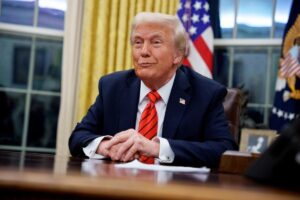
Apple Inc. intends to continue increasing investment in business development in China and further strengthening cooperation with the aim of achieving mutually beneficial development, said the company’s chief executive Tim Cook at a meeting with China’s Minister of Industry and Information Technology Li Lichen.
The minister noted that China’s massive domestic market and comprehensive industrial system have enormous potential in terms of investment and consumption, according to Xinhua News Agency.
“We hope that Apple will continue to develop the Chinese market, actively participate in China’s reindustrialization, and work with Chinese companies to promote innovative development across the entire production chain,” Li Lichen said.
He added that China is committed to a policy of openness to the outside world, intends to promote the application of intelligent technologies in industrialization and the intelligent transformation of industry, and will contribute to the creation of a favorable business environment for enterprises with foreign capital participation, including Apple.

Imports of electric telephone or telegraph apparatus and videophones (HS 8517) to Ukraine in January-September increased by 24.4% compared to the same period in 2024, reaching $1.12 billion, according to statistics from the State Customs Service.
According to statistics, the largest volume of these products was imported from China (54.6% or $613 million), Vietnam (15.2% or $171.2 million), and the United States (8.5% or $95.4 million), while last year it was China (64.1% or $579.1 million), Vietnam (16.3% or $147.1 million), and Malaysia (4.2% or $38 million).
At the same time, exports of these products from Ukraine in January-September 2025 amounted to $92.5 million, 42% more than in the first nine months of last year, mainly to Hungary (71.5%), Poland (23.3%), and the Netherlands (less than 1%). During the same period in 2024, products were exported mainly to the same countries, but Hungary accounted for 60%, Poland for 30.4%, and the Netherlands for 4.5%.
According to the State Customs Service, in 2024, telephone or telegraph equipment worth almost $1.26 billion was imported into Ukraine, which is 10% more than in 2023.

Global demand for steel in 2025 will remain at the previous year’s level — about 1.748 billion tons, after a 1.6% decline in 2024. These figures are given in the short-term forecast of the World Steel Association (Worldsteel) — Short Range Outlook (SRO).
In 2026, according to experts, demand will grow by 1.3% to 1.772 billion tons, driven by recovery in Europe, India, and the rapidly developing countries of Asia, the Middle East, and Africa.
According to Worldsteel’s forecast, in the CIS countries, including Ukraine, demand for steel will decline by 5.2% in 2025, to 56.1 million tons, and by another 1.7% in 2026, to 55.2 million tons.
At the same time, India will retain its status as the world’s fastest-growing steel market, with growth of around 9% annually in 2025-2026. Already next year, steel consumption in India will be almost 75 million tons higher than in 2020.
In developing countries (excluding China), demand for steel will increase by 3.4% in 2025 and by 4.7% in 2026, driven by active economic development in ASEAN countries, as well as in Saudi Arabia and Egypt.
In Africa, steel consumption is growing by an average of 5.5% annually, reaching 41 million tons in 2025 — the highest level in the last decade. Growth is driven by investments in construction and improved macroeconomic indicators.
Andriy Ozeychuk, Chairman of the Board of Directors of the Ukrainian Steel Construction Center and Director of Rauta, commented on the market situation and prospects for the Ukrainian steel sector.
“The Ukrainian steel market in 2025–2026 will be shaped by the recovery of domestic demand in construction and machine building, as well as the growth of exports of metal structures to the EU. We predict that demand for steel in Ukraine may grow by 6-8% in 2026 due to infrastructure and industrial recovery projects,” Ozeychuk said.
According to him, the steel construction sector will be the driver of this growth:
“The use of metal structures will accelerate the restoration of logistics, industrial, and infrastructure facilities.”
Ozeychuk also stressed that the launch of joint programs with European partners in the field of “green” metallurgy, where Ukraine already has its first pilot initiatives for the production of steel with a low carbon footprint, could give the industry an additional boost.
According to the forecast, demand for steel in the EU+UK region will increase by 1.3% in 2025 and by 3.2% in 2026. This reflects the impact of increased investment in infrastructure and defense amid lower inflation and improved household incomes.
In the US, Worldsteel expects steel consumption to increase by 1.8% in both 2025 and 2026. The main drivers of growth will be government spending on infrastructure, a revival in housing construction, and private investment.
In China, steel demand will continue to decline, by approximately 2% in 2025, due to the prolonged downturn in the real estate market. In 2026, the rate of decline will slow to 1% as the construction sector is expected to bottom out.
Worldsteel warns that a more challenging global trade environment and financial pressure on local authorities could further limit infrastructure investment and reduce demand.
According to Alfonso Hidalgo de Calcerrada, chief economist of the Spanish Steel Manufacturers Association (UNESID) and chairman of the Worldsteel Economic Committee, the organization is “cautiously optimistic” about the market outlook:
“Despite trade disputes and uncertainty, we believe that global steel demand will bottom out in 2025 and show moderate growth in 2026,” the expert said.
He added that this will be facilitated by the resilience of the global economy, growth in infrastructure investment, and easing financial conditions. At the same time, the sector continues to be pressured by high costs, trade barriers, and geopolitical risks.
Worldsteel’s forecast emphasizes that the decline in demand in China is offset by strong growth in India and developing countries, where a new center of global steel production is emerging.
In addition, the protective measures introduced by the European Union — reducing duty-free import quotas and increasing customs duties to 50% — may change the balance between EU producers and exporters from Asia and Eastern Europe.
For more information on the largest steel producers and global industry trends, see the Experts Club video analysis review available on YouTube: Experts Club — Leaders of the global steel industry 1990–2024
CHINA, EU, EXPERTS CLUB, global economy, INDIA, OZEYCHUK, RAUTA, USA, World Steel, WORLDSTEEL

The volume of tractor imports to Ukraine in January-September 2025 amounted to $629.41 million, which is 6.2% more than in the same period of 2024 ($582.56 million), according to statistics from the State Customs Service. According to the published statistics, tractors were mainly imported from the US (20.7% of total imports of this equipment, or $130.2 million), China (almost 18% or $113 million), and Germany (16.7% or $105.3 million), whereas a year ago it was Germany (almost $90 million), China ($82.3 million), and the Netherlands ($78 million).
At the same time, imports from other countries in January-September decreased by 17.9% to $280.9 million, and their share in the total volume of tractor imports decreased to 44.6% from 57.8%.
In September this year, tractor imports to Ukraine increased by 23.6% compared to September 2024, to $73.7 million.
Since the beginning of this year, as reported, tractor imports to Ukraine have shown negative dynamics: in January, they were down by a third compared to January 2024, but by the end of the first half of the year, the figures were almost on par with last year’s.
According to statistics from the State Customs Service, $4.5 million worth of tractors were exported in January-September this year, mainly to Romania (28%), Belgium, and Germany, while last year’s exports for the same period amounted to $4.1 million, mainly to Moldova (28%), Kazakhstan, and the Czech Republic.
As reported, tractor imports to Ukraine in 2024 amounted to almost $784 million, 5.6% less than a year earlier, while exports amounted to $5.44 million compared to $5.74 million.

The spot price of gold hit a new record high on Monday. As of 9:34 a.m., it stands at $4068.74 per ounce, which is 1.3% higher than the previous session’s close. Earlier in trading, the spot price of gold rose to $4078.24 per ounce, marking an all-time high. Gold futures on the Comex exchange are up 2.2%, reaching $4087.4 per ounce.
The precious metal is supported by rising tensions between the United States and China, as well as expectations of further interest rate cuts by the Federal Reserve.
On Friday, U.S. President Donald Trump announced the possibility of significantly increasing import tariffs on Chinese goods in response to Beijing’s tightened export controls on rare earth metals. He also said he saw no point in meeting with Chinese President Xi Jinping. However, on Sunday, Trump stated that Washington wants to help Beijing rather than harm it and suggested that he might still meet with Xi later this fall.
In addition, traders expect two more rate cuts by the Fed before the end of the year. According to futures market pricing, the probability of a 25-basis-point rate cut by the U.S. central bank at its next meeting on October 28–29 is estimated at 95.7%. Investors in the derivatives market also expect another similar cut in December.
Earlier, the analytical center Experts Club released an analysis of the world’s leading gold-producing countries in a video on its YouTube channel — https://youtube.com/shorts/DWbzJ1e2tJc?si=9YBue5CS6dz-tA6_

Beijing urges Washington to adhere to previously reached consensuses and considers President Donald Trump’s threats of new tariffs a mistake, the Chinese Ministry of Commerce said.
“China urges the United States to immediately reconsider its mistaken actions, adhere to the important consensuses reached during telephone conversations between the two heads of state, safeguard the hard-won results of consultations, and continue to use the mechanism of China–US trade and economic consultations,” the statement published on the ministry’s website said.
Beijing emphasized that it stands for resolving differences through dialogue, and if Washington insists “on the wrong path,” China will take measures to protect its legitimate rights and interests.
“Deliberate threats of high tariffs are the wrong way to build relations with China,” the ministry stressed. The agency also noted that US statements about possible new tariffs are an example of double standards.
On Saturday night, Trump announced that he intends, starting November 1, “or maybe even earlier,” to impose additional 100% tariffs on goods imported from China.
“Starting November 1, or perhaps earlier, depending on China’s actions, the United States will impose 100% tariffs in addition to the existing ones. In addition, starting November 1, we will implement export control measures for any vital software,” he wrote on Truth Social.
Trump explained that he made this decision because China “declared that starting November 1 it would implement serious export control measures on almost all products manufactured in the PRC.” “This will affect all countries and is clearly a plan that China has been preparing for years,” the US president said.